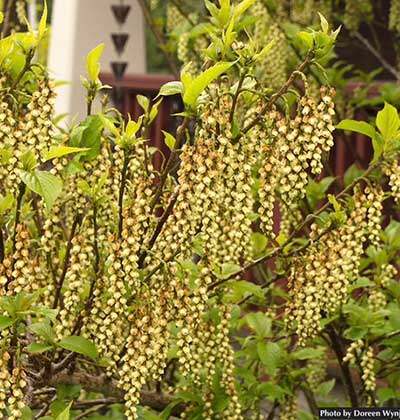Coastal Golden Spiketail Tree
- Scientific Name: Stachyurus praecox var. Matsuzakii
- Garden: Rain Garden
- Plant Type: Shrub
- Evergreen/Deciduous: Deciduous
- Sun/Shade Exposure: Full Sun to Part Shade
- Moisture Requirements: Moist, Well-Drained
Plant Information
Stachyurus praecox is a deciduous shrub that is perhaps best noted for its unique and colorful late winter to early spring flowers that bloom before the foliage emerges. Flower buds form in autumn and overwinter on the plant in pendant, catkin-like racemes that hang from the leaf axils. Each flowering raceme (to 4″ long) typically has 10–20 tiny, bell-shaped, 4-petaled, yellow-green flowers (3/ 8” across). This shrub typically grows to 4-6′ (less frequently to 10′) tall with an open, upright, arching-spreading habit. During the growing season, attractive red-brown to chestnut-brown branches are clothed (sometimes sparsely) with ovate, tapered, serrate, medium green leaves (to 7″ long). Foliage may turn rosy red and yellow in fall.
Best grown in light, humusy, acidic, moist but well-drained soils in full sun to light shade. where plants should be sited in protected locations that Unprotected flower buds may be damaged by frost. Shrubs flower on old wood, so pruning should be done in early spring immediately after flowering. Remove flower shoots to the base on mature plants.
Data Source
https://www.missouribotanicalgarden.orgPlant Photos







